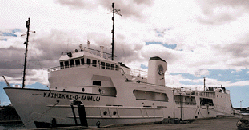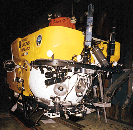

Loihi Event Response Expedition August 1996
Visit these Recent Activity Links Too:



SHIP: R/V Ka'imikai-o-Kanaloa, with Pisces V manned submersible


TENTATIVE SCIENCE PARTY:
1) Duennebier, Fred Chief Scientist sonobuoys, seismic, SeaBeam
2) Sansone, Frank Co Chief, water chemistry
3) Midson, Brian CTD, water chemistry
4) Kolotyrkina, Irina, water chemistry
5) Resing, Joe, water chemistry
6) Wen, XI Yuan, biology
7) Rust, Terri, water chemistry
8) Becker, Nathan, rocks
9) McLaughlin, Betsy water chemistry
10) Jim Gharib water chemistry
11) Holloway, Chuck camera
12) Johnson, Kevin rocks (Bishop Museum)
13) Jenifer Reynolds rocks (HVO)
SHORE-BASED RESEARCHERS NOT LISTED ABOVE:
1) Batiza, Rodey rocks
2) Cowen, Jim water chemistry/microbiology
3) Garcia, Mike rocks
4) Kong, Laura seismology
5) Malahoff, Alex HURL
6) Okubo, Paul seismology
7) Ken Rubin geochronology
8) Wheat, Jeff water chemistry
CRUISE PLAN:
As noted in the pre-cruise meeting, this plan is very open to changes
based on conditions we find at the site.
Day Date Time Activity
TODAY 8/2 - Load Ship, test equipment
1 8/5 0700 Depart Honolulu
2 8/6 0700 Arrive Loihi after 24 hr transit. Check surface
waters for signs of eruptive activity - discolored watrer, pumice, etc.
CTD cast to obtain up-to-date water velocities and initial evaluation of
plume activity. Deploy and record sonobuoys on approach to summit to get
an initial indication of acoustic activity.
2 8/6 1500 Begin transponder array (long baseline acoustic
navigation) tests. Begin initial SeaBeam survey to look for gross changesin topography. Deploy transponders as necessary. Calibrate transponder
array.
2 8/6 2200 Begin CTD rosette and tow-yo casts.
0600 Evaluate CTD, SeaBeam, and sonobuoy results.
Decision on if and where to conduct 1st dive, with pre-cruise preference
for Pele's vents .
3 8/7 0700 A) Begin PISCES Dive 1. PISCES places
instruments, collects rock samples, surveys and documents activity. KOK
continues SeaBeam coverage in immediate area.
OR
B) If safety, weather or the lack of a clear target preclude a dive,
continue CTD and CTD tow-yo casts.
3 8/7 1600 End PISCES Dive 1. CTD rosette casts on grid and
as modified by suspected plume location. Continued sonobuoy monitoring of
activity.
4 8/8 0700 A) Begin PISCES Dive 2. PISCES samples vent and
plume waters, collects rock samples, continues documentation.
OR
B) If safety, weather or the lack of a clear target preclude a dive,
continue CTD and tow-yo casts.
4 8/8 1600 End PISCES Dive 2. CTD rosette casts on grid andas modified by suspected plume location. Continued sonobuoy monitoring of
activity.
5 8/9 0700 A) Begin PISCES Dive 3. PISCES samples vent and
plume waters, collects rock samples, continues documentation of eruptive
activity.
OR
B) If safety, weather or the lack of a clear target preclude a dive,
continue CTD and tow-yo casts.
5 8/9 1600 End PISCES Dive 3. Re-survey active areas with
SeaBeam, fill in any holes in water sampling grid.
6 8/10 2100 Depart Loihi
6 8/10 2000 Return Honolulu after 23 hour transit

![]() Return to the Hawaii Center for Volcanology LOIHI Page
Return to the Hawaii Center for Volcanology LOIHI Page
 Return to the Hawaii Center for Volcanology Home Page
Return to the Hawaii Center for Volcanology Home Page
This page created and maintained by
Ken Rubin,©
krubin@soest.hawaii.edu
Other credits for this web site.
Last page update on 1 August 1996

|